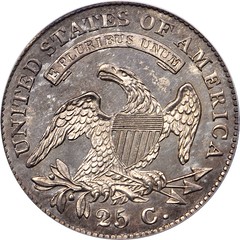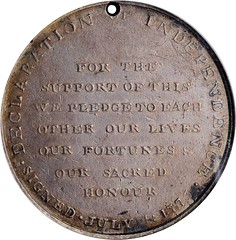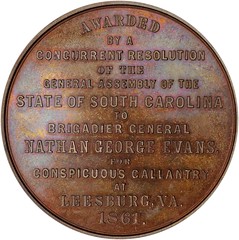
PREV ARTICLE
NEXT ARTICLE
FULL ISSUE
PREV FULL ISSUE
STACK'S BOWERS AUGUST 2021 AUCTION SELECTIONSHere are several lots that caught my eye in the upcoming Stack's Bowers ANA World's Fair of Money sales. -Editor 

The Mickley-Norweb Specimen of the Original 1827/3/2 Quarter This is perhaps the most famous Original 1827 quarter, no doubt due to the aforementioned story about Joseph J. Mickley acquiring four Proof 1827 quarters directly from the Philadelphia Mint in late 1827 in change for a dollar. Inasmuch as this is the specimen included in W.E. Woodward's October 1867 sale of the Mickley Collection, this coin has long been described as "J.J. Mickley's Favorite" 1827 quarter. As previously stated, there is no evidence that Mickley ever owned more than one 1827 quarter, and even less evidence for his having acquired any 1827 quarters from the Mint in 1827. There is, however, likely a nugget of truth to this story. As one of the nine founding members of the Numismatic and Antiquarian Society of Philadelphia (along with other early 1827 quarter owners Arthur G. Coffin and John Bohlen), Mickley almost certainly acquired his specimen directly from the Mint, although most likely during the 1850s, and in trade for items desired for the Mint Cabinet Collection not as change for a dollar. When offered in the 1867 Mickley Collection sale, this coin was lotted as part of a three-piece Proof "set" with an 1827 dime and half dollar, seemingly a concoction of Woodward's to create excitement among bidders. Selling to Joseph P. Reakirt, the coin appeared at the 1962 ANA Convention, and shortly after found its way into the collection of Ambassador and Mrs. R. Henry Norweb. It remained part of the Norweb holdings until sold in Part II of our (Bowers and Merena's) sale of the Norweb Collection, March 1988. Returning to auction in our (Bowers and Merena's) May 1993 Stetson University Collection sale, the coin then entered the renowned cabinet of Dr. William Morton-Smith, whose family has consigned it to the present auction. This sale of the famous Mickley-Norweb Original 1827/3/2 quarter is not the first time Stack's Bowers Galleries has worked with the family. Previously we were selected to bring to market Bill's 1804 dollar, pedigreed to the Berg and Garrett collections; his 1794 dollar, the Lord St. Oswald/Norweb specimen; and the Eliasberg 1913 Liberty Head nickel. A classic rarity with a classic pedigree. The the complete lot description online for a survey of the numismatic literature around this issue. -Editor
To read the complete lot description, see:


1796 Capped Bust Right Quarter Eagle. Stars on Obverse. BD-3. Rarity-5+. MS-62 (PCGS). This is one of the most significant and exciting offerings in this sale - a fresh Mint State 1796 Stars Obverse quarter eagle that has recently been certified by PCGS for the first time and is making its debut in the modern numismatic market. It is a poster example of a classic early U.S. Mint gold rarity. The offered example is solidly in the Mint State category and offers both absolute and condition rarity. Even more significant, this coin was last offered for sale in the 1970s and, as such, is making its debut in the modern numismatic market. Its earliest known provenance dates to 1926, when the coin was sold by Elmer Sears. A coin dealer in Fall River, Massachusetts, Elmer Snow Sears conducted auctions from 1904 to 1910. He later joined Wayte Raymond in the U.S. Coin Co. in New York and issued a few undated fixed price lists. 
This is the coin we discussed in June when Ron Gillio passed along the lot description. -Editor
To read the complete lot description, see:
To read the earlier E-Sylum article, see:


1826 U.S. Semicentennial, The National Medal. HK-2. Rarity-9. Silver. AU-55 (NGC). 40 mm. Pierced for suspension, as always. Exceptional quality for this important rarity in the HK series. Handsome pearl-gray surfaces with steely-olive peripheral toning on the obverse, the obverse border with a few glints of russet associated with light surface scale. Appealing satin to matte-like texture throughout, with all design elements boldly to sharply rendered. Although the origin of this type is unknown, its issuance to commemorate the 50th anniversary of the Declaration of Independence confirms its historical significance and desirability. Silver impressions such as this are the most desirable, although they are formidable rarities with only a handful known. Incredibly, our (Stack's) May 2005 Ford IX Sale included three (!) silver impressions, along with two in white metal (HK-4) and an obverse brockage in brass - an unprecedented offering likely never to be repeated. The offered medal is distinct from the Ford specimens and represents a rare bidding opportunity for specialists. Unusual item, and interesting. I don't believe I've seen one of these before. -Editor
To read the complete lot description, see:


1862 Sands' Ale. Five Cents. HB-207, EP-90, S-151, Reed-SA05. Rarity-8. Extremely Fine, Environmental Damage. No more than four denominations of Sands' Ale encasements are believed to exist and, although it is the most readily obtainable, the five cents is still a major rarity with Fred L. Reed assigning it a Rarity-8 rating in his 1995 book Civil War Encased Stamps: Their Issuers and Their Times. The ten cents is Rarity-9 with only two or three specimens known, the thirty cents is believed unique, and Reed notes only a "?" alongside his listing for the twelve cents. The twenty-four cents does not exist for this issuer. The present five cents is the plate piece in the popular 1989 reference The Standard Catalogue of Encased Postage Stamps by Michael J. Hodder and Q. David Bowers, and it is one of the most significant encasements from any issuer that we have offered in recent years. A fleeting bidding opportunity for the specialist that is worthy of serious consideration. Provenance: From the Q. David Bowers Collection. Earlier ex our (American Numismatic Rarities') sale of the Wayne Homren Collection, June 2006 Lake Michigan & Springdale Collections sale, lot 840, where it realized $18,400; Q. David Bowers. The plate piece in the Hodder-Bowers reference on encased postage stamps. An old friend. I miss my encased postage collection. This one found a good home with Dave Bowers, and is ready for the next curator to come along. I purchased it from Dr. Wally Lee, making a downpayment and paying in installments over several months. -Editor
To read the complete lot description, see:


1861 South Carolina Medal to General Nathan George Evans. B861-525c. Bronzed Copper. Prooflike Mint State. 57 mm. Obv: Palmetto tree and Motto ANIMIS OPIBUSQUI PARATI from the South Carolina State Seal. Rev: Fourteen-line inscription AWARDED / BY A / CONCURRENT RESOLUTION / OF THE / GENERAL ASSEMBLY OF THE / STATE OF SOUTH CAROLINA / TO / BRIGADIER GENERAL / NATHAN GEORGE EVANS / FOR / CONSPICUOUS GALLANTRY / AT / LEESBURG, VA. / 1861. Evans was a first lieutenant in the U.S. Army when his home state, South Carolina, became the first state to secede from the Union. He resigned his commission, joined the Confederate Army, was given the rank of colonel, and assigned to a small brigade that prominently participated in the First Battle of Bull Run -- the initial conflict between armies of the U.S.A. and the C.S.A. Three months later at the Battle of Ball's Bluff, Evans' troops successfully routed Union troops that were crossing the Potomac River in an attempt to overrun Evans' camp, but due to errors of strategy on the part of the Union forces, Evans' division forced them back over the bluffs and into the river where most were killed or captured. These early successes earned Colonel Evans promotion to brigadier general. This rare medal was issued by the Confederate State of South Carolina for actions during the opening months of the war, and one must speculate where the medal was produced. There were no medalists capable of producing a medal of this size and quality in the South, so perhaps it was contracted out to one of the European mints, or conceivably it was produced clandestinely by a medalist in the U.S. It is unsigned, but bears a strong resemblance to the work of Robert Lovett, Jr. of Philadelphia who had the skill and machinery to produce such a medal. His Washington Light Infantry medal of 1860 bears a close stylistic resemblance to this piece. Additionally, Lovett may well have had sympathies for the Confederate cause as he is known to have been illegally contracted to produce the 1861 Confederate cent. Although Lovett typically signed his work prominently, his Confederate cent could not bear an indication of the maker, as is the case with this medal.
A rarely seen medal, with a local connection for me - we live near Leesburg, and the Ball's Bluff battle site is only 10 miles away. -Editor
To read the complete lot description, see:


Maryland--Baltimore. HOUCK'S / PANACEA / BALTIMORE in relief within an oblong depression on the obverse of a France undated Paris Mint Force Type 5 francs. Brunk H-779, HT-144. Host coin Very Good. A rare undertype. -Editor
To read the complete lot description, see:


Louisiana--New Orleans. PHILLIPS, / CHEAP / STORE. / NAYADES ST. / N. O. on the obverse of a Sardinia 1850 5 lira. Brunk P-449, Rulau-La 104A. Host coin Fine. Attractively original host coin in silver and olive-gray, the counterstamp firmly impressed. Scarce merchant, in business only from 1849 to 1855, whose counterstamp is particularly elusive on a host of this type. In fact, both the Brunk and Rulau references only report a single Sardinian 5 lira host, an example dated 1844. Rare! Provenance: From the Q. David Bowers Collection. While U.S. merchant counterstamps on foreign coins aren't rare, this Italian coin is an undertype I've never seen. Like the Houck's Panacea above, the counterstamp is equally rare evidence of where and when the coin circulated in the U.S. -Editor
To read the complete lot description, see:


1855 Liberty Head Quarter Eagle--Broadstruck--MS-63 (NGC). In a word, major Mint errors on classic United States gold coins are rare. Only a handful are known across all series and major Mint error types, and expectantly so since the Mint's quality control procedures were much stricter for gold coins than they were for silver and, especially, minor coins. The 2010 reference 100 Greatest U.S. Error Coins does not feature this specific 1855 quarter eagle, but it does rank a broadstruck 1897 Liberty Head half eagle as #32, the entry for which also pictures a broadstruck 1878-S Liberty Head quarter eagle. Failing to properly seat itself within the collar, the planchet on which this 1855 quarter eagle was struck instead lay atop the collar. The resulting impression from the dies, while imparting full detail to all design elements, caused the planchet to spread out, which is most readily evident as crescents of unstruck planchet along the upper left obverse and lower left reverse. A super rarity. Mint errors are a window into the manufacturing process, and early gold errors are seldom seen. -Editor
To read the complete lot description, see:

Wayne Homren, Editor The Numismatic Bibliomania Society is a non-profit organization promoting numismatic literature. See our web site at coinbooks.org. To submit items for publication in The E-Sylum, write to the Editor at this address: whomren@gmail.com To subscribe go to: https://my.binhost.com/lists/listinfo/esylum All Rights Reserved. NBS Home Page Contact the NBS webmaster 
|